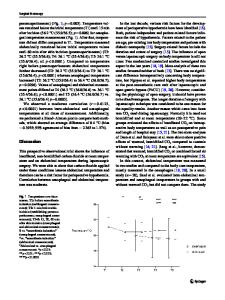Effects of low- and high-pressure carbon dioxide pneumoperitoneum on intracranial pressure during laparoscopic cholecyst
- PDF / 506,228 Bytes
- 5 Pages / 595.276 x 790.866 pts Page_size
- 5 Downloads / 315 Views
and Other Interventional Techniques
Effects of low‑ and high‑pressure carbon dioxide pneumoperitoneum on intracranial pressure during laparoscopic cholecystectomy T. Yashwashi1 · Lileswar Kaman1 · Kamal Kajal2 · Divya Dahiya1 · Ashish Gupta1 · Shyam C. Meena2 · Kaptan Singh1 · Abhinaya Reddy1 Received: 19 June 2019 / Accepted: 9 October 2019 © Springer Science+Business Media, LLC, part of Springer Nature 2019
Abstract Background Laparoscopic surgeries are a risk factor for raised intracranial **pressure and neurological complications. Even though rare, the consequences may be severe. Methods One hundred and one patients of laparoscopic cholecystectomy were enrolled and were randomized into two groups: low-pressure 8 mm Hg (Group A) and high-pressure 14 mm Hg (Group B) carbon dioxide pneumoperitoneum during surgery. Fifty patients were in group A and 51 patients were in group B. Intracranial pressure was measured by measuring the optic nerve sheath diameter (ONSD) using ultrasound examination. Baseline ONSD was recorded followed by ONSD recording at various intervals: at the induction of anesthesia; 30 min, 45 min, at the end of surgery; and 30 min post surgery. Results The groups were comparable in terms of demographics and comorbidities. The mean age of group A was 45 years and for group B it was 45.75 years. Most common indication for surgery was symptomatic gall stone disease. Baseline ONSD in group A was 0.427 ± 0.0459 mm, whereas it was 0.412 ± 0.0412 mm in group B. There was a significant rise of ONSD (p 20 mm hg). NIRS is a recent innovation that works on the principle of variable absorption of light in infrared region for detecting concentration changes in oxygen and deoxyhemoglobin. Its reliability and predictability for detecting changes in cerebral blood flow and ICP has been studied extensively in head injury patients. The major limitations are the wide intraindividual and interindividual variation in the regional cerebral tissue oxygen saturation and signal contamination by extracranial tissue [17]. The present study was intended to document the change of ICP with varying intra-abdominal pressures. ONSD measurement was taken as a surrogate marker for ICP measurement. Our results demonstrate that all the patients undergoing laparoscopic cholecystectomy had normal baseline ICP according to ONSD measurement. This may be due to our stringent patient selection. And no patients had raised ICP to define them as intracranial hypertension at the cut-off value of 5.7 mm of ONSD. There were definite variations and ICP changes during surgeries in many patients. These changes and variations were more pronounced in the high-pressure pneumoperitoneum group. Out of 50 patients in the lowpressure pneumoperitoneum group, only 7 (14%) patients had significant rise in ICP. In the high-pressure pneumoperitoneum group, these changes were noticed in 20 (39.2%) patients. Even though this difference in ICP was small, it was significant in the two groups (p 0.05). So in high-risk patients it is advisable to operate in l
Data Loading...











